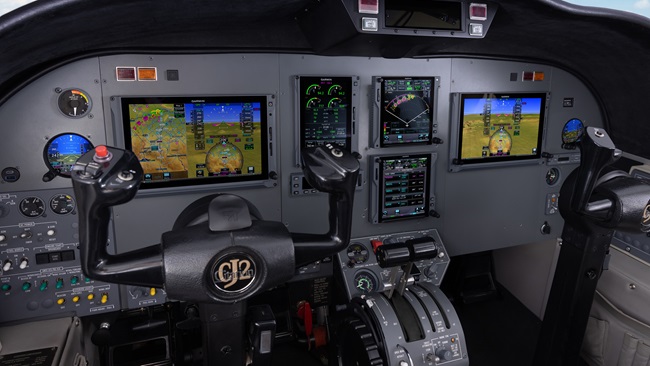Additional NavWorx AMOCs issued
Deadline for AD compliance is Jan. 11
Two new alternative methods of compliance (AMOCs) for the airworthiness directive affecting most NavWorx Inc. universal access transceivers (UATs) were recently approved by the FAA, allowing the NavWorx ADS600-B to be used with certain Avidyne GPS receivers and the ADS600-EXP to be used only for Automatic Dependent Surveillance-Broadcast (ADS-B) In services. They join three AMOCs issued in August that allow the NavWorx UATs to be used with a variety of popular Garmin GPS receivers.
ADS-B uses satellites instead of ground-based radar to determine aircraft location, and is a key technology behind the FAA’s Next Generation Air Transportation System. The FAA has mandated installation of ADS-B Out for flights after Jan. 1, 2020, in airspace where a transponder is required today.
NavWorx’s UATs were designed to provide ADS-B Out and In on 978 MHz. An AD issued June 6 requires that, by Jan. 11, 2018, owners of aircraft with the affected UATs disable the unit; upgrade the software, which makes the unit noncompliant with the FAA’s 2020 ADS-B Out mandate; or couple the UAT to an approved GPS position source. The AD's full text is available online.
Avidyne position sources
Florida-based Rob Kermanj was an early adopter of the NavWorx ADS600-B, expecting it to provide 2020 compliance for his Van’s RV-10. “I bought it very early,” he explained. Originally he had a Garmin GNS 430 in the airplane, and about 18 months ago replaced it with an Avidyne IFD440 touchscreen FMS/GPS/NAV/COM. Kermanj had talked with Bob Leffler, who obtained the AMOC for the Garmin GTN 650- and GTN 750-series navigators—and, in fact, used Leffler’s proposal letter as the basis for his own AMOC.
He contacted the Fort Worth Flight Standards District Office, which issued the AD. “I told them how I had wired the Avidyne,” he said. The office requested a recent ADS-B performance report—“in my case, it was just a recent, normal flight”—and a bit more information, Kermanj said. In fact, the FAA contacted him to ask if it would be OK to add Avidyne’s IFD540 to the AMOC, since both use the same position source. “It was a very simple process,” he added.
The AMOC requires that the Avidyne navigator be running software version 10.2 or later to support the ADS-B OUT+ protocol.
ADS600-EXP for ADS-B In only
John Austin of Tennessee built his Zenith STOL 750 about five-and-a-half years ago, and installed a NavWorx ADS600-EXP soon after. “I put in the NavWorx when it first became available,” he said.
In reviewing the manual, Austin found a way to disable the ADS-B Out transmissions, and thought he could maintain some of the value of his UAT by using it only for ADS-B In. “I sent the FAA an email and told them what I had discovered about disabling the NavWorx,” he said. The FAA followed up with a number of questions, and then issued the AMOC. “It was really a pretty painless process.” Because the ADS600-EXP is not certified, this AMOC can be used only on experimental and light sport aircraft.
“The irony is that when I was doing the NavWorx AMOC, there was an indication there might be some interference with a UAT Out solution I was testing.” When the nontransmitting ADS600-EXP was powered on, FAA Public ADS-B Performance Reports that he requested all showed a 100-percent failure of the barometric altitude parameter. Transmission by the ADS600-EXP was disabled through the configuration console, Austin explained, and the source of the interference could not be identified. He has not tested the In-only AMOC with a 1090-MHz Extended Squitter (1090ES) ADS-B Out transponder; because it operates on a different frequency, it might not be subject to interference. “Ironically for me, I may not get to use my AMOC with my new UAT. However, I don’t know if the interference is unique to my installation or unique to that particular [ADS-B Out] device.”
Austin’s approval letter references an email with instructions to comply with the AMOC. Those steps are:
- Utilize the NavWorx “UAT Console EXP (avionics installer)” configuration software to access the ADS600-EXP.
- Set the “Transponder Interface” input box to “NONE.”
- Verify the transmitter has been disabled by assuring the software displays a red box “UAT not configured for flight.”
- Place a placard on the ADS600-EXP unit “NavWorx ADS600-EXP UAT Transmitter Disabled.”
- Perform a test flight, request a FAA Public ADS-B Performance Report, and verify that no report was generated to verify the UAT transmitter is disabled.
- Make a logbook notation that the NavWorx ADS600-EXP UAT transmitter is disabled and now functions as an ADS-B In-only receiver.
More information on the process can be found on the Zenith Aircraft Builders and Flyers blog, which Austin moderates.
Austin said an aircraft owner on a Van’s RV forum mentioned seeking a similar AMOC for the certified ADS600-B. “It looks to me like it would be a slam dunk,” he said, although he is not aware of anyone yet making the effort to do so.
The three initial AMOCs, for Garmin GPS position sources, were obtained by Bob Leffler, GTN 650 and GTN 750 series; Ralph Capen, GNS 430W and GNS 530W series; and Phil Yoder, GNS 480. Before a private operator can utilize any of the AMOCs, he or she must notify the manager of the local FAA fight standards district office.




